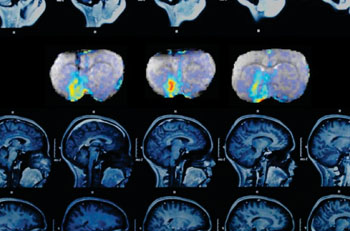Neuroscientists Use MRI Sensors to Map Neural Activity
By MedImaging International staff writers
Posted on 14 May 2014
Investigators have devised a new technique that allows them to track neural communication in the brain over time, using magnetic resonance imaging (MRI) combined with a specialized molecular sensor. Posted on 14 May 2014
The US BRAIN Initiative, launched in 2013, has a goal to transform the understanding of cognition by mapping the activity of every neuron in the human brain, revealing how brain circuits interact to create memories, learn new skills, and interpret the surrounding environment.

Image: A series of three MRI images (top row) shows how dopamine concentrations change over time in the brain’s ventral striatum (Photo collage courtesy of Christine Daniloff/MIT, with images courtesy of the MIT researchers).
To accomplish this, neuroscientists need new approaches that will let them examine the brain more comprehensively and in greater detail, according to Dr. Alan Jasanoff, a Massachusetts Institute of Technology (MIT; Cambridge, MA, USA) associate professor of biological engineering. “There’s a general recognition that in order to understand the brain’s processes in comprehensive detail, we need ways to monitor neural function deep in the brain with spatial, temporal, and functional precision,” he said.
Dr. Jasanoff and colleagues have now moved closer toward that objective. This is the first time researchers has been able to map neural signals with high precision over large brain regions in living animals, providing new insights into brain function, according to Dr. Jasanoff, who is also an associate member of MIT’s McGovern Institute for Brain Research.
The scientists used this molecular imaging approach, described May 2, 2014, in Science, to explore the neurotransmitter dopamine in a region of the brain called the ventral striatum, which is involved in reward, motivation, and reinforcement of behavior. Dr. Jasanoff plans in future research to combine dopamine imaging with functional MRI techniques that measure overall brain activity to gain a better determination of how dopamine levels affect neural circuitry. “We want to be able to relate dopamine signaling to other neural processes that are going on,” Dr. Jasanoff stated. “We can look at different types of stimuli and try to understand what dopamine is doing in different brain regions and relate it to other measures of brain function.”
Much of the brain’s dopamine is generated by a structure called the ventral tegmental area (VTA). This dopamine moves through the mesolimbic pathway to the ventral striatum, where it combines with sensory data from other parts of the brain to reinforce behavior and help the brain learn new tasks and motor functions. This circuit also plays a major role in addiction.
To monitor dopamine’s role in neural communication, the researchers utilized an MRI sensor they had previously designed, consisting of an iron-containing protein that acts as a weak magnet. When the sensor binds to dopamine, its magnetic interactions with the surrounding tissue weaken, which dims the tissue’s MRI signal. This allows the researchers to see where in the brain dopamine is being released. The researchers also developed an algorithm to calculate the exact amount of dopamine present in each fraction of a cubic millimeter of the ventral striatum.
After delivering the MRI sensor to the ventral striatum of rats, the scientists electrically stimulated the mesolimbic pathway, and were able to identify exactly where in the ventral striatum dopamine was released. An area known as the nucleus accumbens core, known to be one of the key targets of dopamine from the VTA, showed the highest levels. The researchers also observed that some dopamine is released in neighboring regions such as the ventral pallidum, which controls motivation and emotions, and parts of the thalamus, which transmits sensory and motor signals in the brain.
Each dopamine stimulation session lasted for 16 seconds and the researchers captured an MRI image every eight seconds, allowing them to monitor how dopamine levels changed as the neurotransmitter was released from cells and then disappeared. “We could divide up the map into different regions of interest and determine dynamics separately for each of those regions,” Dr. Jasanoff remarked.
The researchers plan to expand the research by increasing their studies to other parts of the brain, including the areas most affected by Parkinson’s disease, which is caused by the death of dopamine-generating cells. Dr. Jasanoff’s lab is also working on sensors to track other neurotransmitters, allowing them to study interactions between neurotransmitters during different tasks.
Related Links:
Massachusetts Institute of Technology














